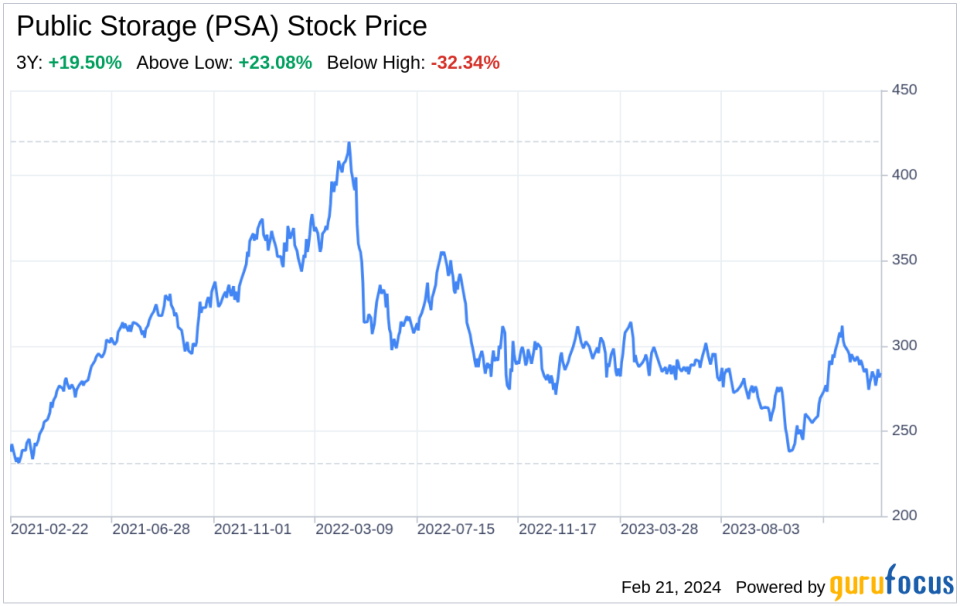Decoding Public Storage (PSA): A Strategic SWOT Insight
Public Storage (NYSE:PSA) maintains a dominant position as the largest owner of self-storage facilities in the U.S.
PSA's brand recognition and technological advancements provide a competitive edge in the fragmented self-storage industry.
Opportunities for growth through acquisitions, development, and ancillary business activities are evident from the latest 10-K filing.
Challenges include intense competition, regulatory compliance, and environmental risks that could impact operations and costs.
On February 20, 2024, Public Storage (NYSE:PSA), the leading owner of self-storage facilities in the United States, filed its annual 10-K report, revealing a comprehensive overview of its financial and operational status for the fiscal year ended December 31, 2023. With a vast network of over 3,000 self-storage facilities across 40 states and a market capitalization of approximately $43.99 billion as of June 30, 2023, PSA continues to solidify its market leadership. The company's financial tables reflect a robust business model, with significant investments in technology and customer experience enhancements, contributing to its strong financial performance. The filing also outlines PSA's strategic growth initiatives, including acquisitions, development of new facilities, and expansion of ancillary services such as tenant reinsurance and third-party management. This SWOT analysis delves into the strengths, weaknesses, opportunities, and threats as presented in the 10-K filing, providing investors with a nuanced understanding of PSA's market position and future prospects.

Strengths
Brand Recognition and Market Leadership: Public Storage (NYSE:PSA) stands as the largest owner of self-storage facilities in the U.S., commanding approximately 9% of the country's self-storage square footage. This scale, coupled with the iconic orange color and recognizable brand, gives PSA a significant competitive advantage. The company's brand awareness is a testament to its long-standing presence and marketing efforts, which have translated into high occupancy levels and the ability to command premium pricing.
Technological Advancements: PSA's investment in technology has revolutionized the customer experience, with approximately 81% of move-ins in 2023 sourced through its website. The eRental process and Public Storage App further streamline the rental process, enhancing convenience and operational efficiency. These digital tools not only improve customer satisfaction but also contribute to revenue optimization and cost savings.
Financial Strength: The company's financial health is robust, with a market capitalization of $43.99 billion as of mid-2023. PSA's financial stability is underpinned by its ability to generate high operating margins and maintain a low level of administrative costs relative to revenues. This financial strength provides the flexibility to pursue growth opportunities and weather economic downturns.
Weaknesses
High Fragmentation and Competition: Despite being the market leader, the self-storage industry's high fragmentation means that PSA faces significant competition from regional and local operators. This competition can impact rental rates, occupancy levels, and operating expenses. While PSA's scale and brand offer advantages, the company must continuously innovate to maintain its market position against numerous smaller competitors.
Dependence on Economic Conditions: The performance of self-storage facilities is closely tied to economic conditions, including employment rates and housing markets. Economic downturns can lead to decreased demand for storage space, affecting PSA's revenue and profitability. The company's reliance on such external factors poses a risk to its financial stability during economic contractions.
Regulatory Compliance Costs: PSA's operations are subject to various federal, state, and local regulations, including environmental, labor, and health and safety laws. Compliance with these regulations can result in significant costs, and any changes in the regulatory landscape could adversely affect the company's operations and financial performance.
Opportunities
Acquisitions and Development: PSA's knowledge of major U.S. markets and its financial resources position it well to capitalize on the fragmented nature of the self-storage industry through strategic acquisitions and development of new facilities. The company's aggressive growth strategies aim to leverage its scale and expertise to expand its footprint and enhance its market share.
Ancillary Business Growth: The expansion of PSA's tenant reinsurance and third-party management services presents opportunities for additional revenue streams. Initiatives like the Savvy Storage Insurance Program can attract other storage facility owners, increasing PSA's influence in the industry and providing growth beyond traditional self-storage operations.
Technological Innovation: Continued investment in technology can further differentiate PSA from competitors. Innovations in customer experience, operational efficiency, and revenue management can drive growth and profitability, positioning PSA as a forward-thinking leader in the self-storage industry.
Threats
Intense Industry Competition: The self-storage industry's competitive landscape is constantly evolving, with new entrants and existing operators expanding their presence. PSA must navigate this competition to retain its market leadership, requiring ongoing investment in marketing, technology, and customer service to stay ahead.
Regulatory and Environmental Risks: Changes in regulations, particularly those related to environmental stewardship, can impose additional operational and financial burdens on PSA. The company must manage these risks proactively to ensure compliance and mitigate potential impacts on its business model and reputation.
Economic Fluctuations: The self-storage industry is sensitive to economic cycles, and PSA's performance is not immune to these fluctuations. Economic downturns can lead to reduced demand for storage, impacting rental income and occupancy rates. PSA must remain agile and responsive to economic trends to maintain its financial health.
In conclusion, Public Storage (NYSE:PSA) exhibits a strong market presence, bolstered by its brand recognition, technological advancements, and financial stability. However, the company must navigate the challenges of a highly competitive and fragmented industry, economic sensitivity, and regulatory compliance. PSA's opportunities for growth through acquisitions, development, and ancillary business activities are promising, but it must remain
This article, generated by GuruFocus, is designed to provide general insights and is not tailored financial advice. Our commentary is rooted in historical data and analyst projections, utilizing an impartial methodology, and is not intended to serve as specific investment guidance. It does not formulate a recommendation to purchase or divest any stock and does not consider individual investment objectives or financial circumstances. Our objective is to deliver long-term, fundamental data-driven analysis. Be aware that our analysis might not incorporate the most recent, price-sensitive company announcements or qualitative information. GuruFocus holds no position in the stocks mentioned herein.
This article first appeared on GuruFocus.
